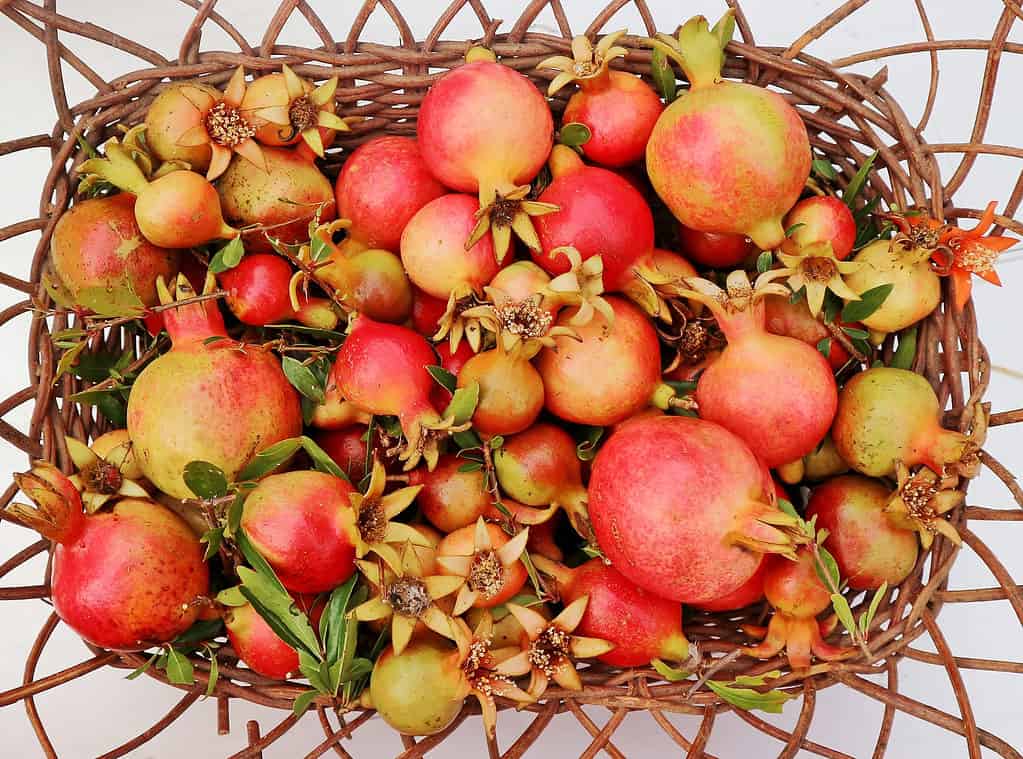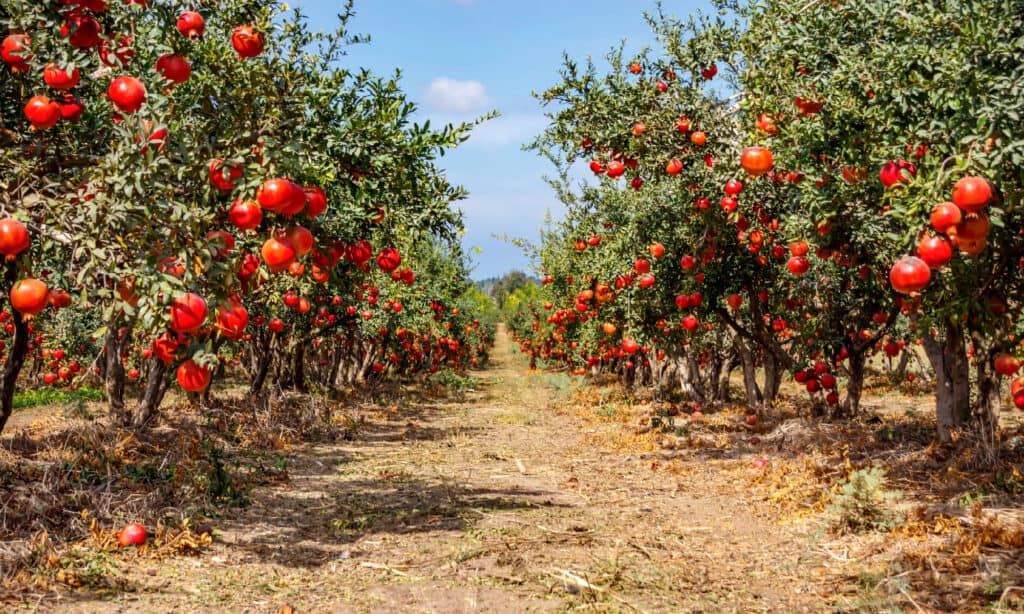The pomegranate is one of the hot-topic fruits that is gaining popularity all throughout the nation. Pomegranates seem to be everywhere these days, with the fruit popping up in the produce area of local grocery stores and appearing in an increasing number of trendy recipes online.
Have you ever wondered how to plant a pomegranate tree in your own yard, though, as a gardener? Is it difficult? What is required? Is it even possible to get pomegranates to fruit in a backyard garden?
In this guide, we’ll explore the rich history of pomegranates and break down, in detail, how to grow your very own pomegranate tree in your backyard.
The Botanical Name And History Of Pomegranate
Punica granatum is the botanical name of pomegranate. It is a fruiting deciduous tree or shrub that can reach up to 33 feet tall. It is a member of the Lythraceae family of plants and the Punica genus of fruit trees and is thus related to plants like the Socotran pomegranate, the Pride of India plant, the false heather, and many more.
Pomegranate trees provide mouthwatering fruit that is popular in different cultural cuisines. If you live in a warm area, they are low-maintenance and resistant to most pests and illnesses. The delicious and edible seeds of the fruits have a red, leathery exterior and some antioxidant health advantages as well.
The pomegranate tree can grow to be a 20 to 33-foot tree or a three-foot dwarf shrub. A typical pomegranate bush is 12 to 16 feet tall and has a rounded appearance. They are mostly deciduous, but in warmer areas, they might be evergreen. With glossy foliage and fiery red, tube-shaped blooms that appeal to hummingbirds and other pollinators, they are equally lovely as ornamental plants for landscaping purposes. The pomegranate can also be made into a small bonsai tree. The branches often have spines and the bark is a reddish-brown tint.
The Mediterranean area is where pomegranate was first mentioned. It was brought by Spanish immigrants to California in 1769 and into Spanish America in the late 16th century. The pomegranate is a native of northern India and modern-day Iran. Pomegranates have been grown for many centuries throughout the Middle East, southern Asia, and the Mediterranean regions. They are also grown in California and Arizona. Being one of the first fruit plants to be domesticated in the eastern Mediterranean region, pomegranates likely have been domesticated as early as the fifth millennium BC.
Today, pomegranate trees are grown commercially around the world but are mostly produced in India and China.
There are several pomegranate tree varieties available in the plant market today. They are not too difficult to find, and some of them are more tolerant to cold temperatures. The Sweet pomegranate type, as its name implies, has a highly sweet flavor and typically yields a large crop early when compared to certain varieties. The Nana pomegranate is a dwarf variety that grows to a maximum height of four feet and is hardy to USDA hardiness zone seven. The Wonderful variety, which abundantly yields large, tasty, red fruits late in the season, is the most widely produced cultivar in the United States.

Pomegranate fruits (pictured) are easy to grow in large yields and can keep off the tree for quite some time.
©luca pbl/Shutterstock.com
Climate And Hardiness Zone Requirements For Pomegranate
Pomegranate trees thrive in USDA hardiness zones seven through 10. They cannot handle cold well at all but can withstand a bit of heat. Pomegranates need an environment with hot summers and moderate winters that is semi-arid to subtropical. When exposed to cold gradually, these plants will harden off, but below 12 degrees F, they often suffer harm and eventually die. Some extremely hardy varieties and cultivars can endure low temperatures of about 7 degrees F. In general, it is best to only grow these plants in the designated hardiness zones for the best chances of high fruit yields.
When To Grow Pomegranates
The pomegranate tree, which is somewhat drought tolerant, is ideal for the sunniest and warmest areas of the yard where other plants can become scorched. When any threat of a late frost has gone, spring is the ideal time to plant young trees. Typically, it takes them two to three years to produce fruit.
Starting Pomegranates From Seed Vs. Buying Adult Plants
In general, it is recommended to try growing pomegranates from seeds, as juvenile plants can be difficult to find anywhere other than online specialty nurseries. That being said, it is also not really recommend to use seeds from pomegranate fruits found at the grocery store. These fruits are usually hybrids, meaning that their seeds will likely not produce trees that are the same variety as the fruit. However, if you can get your hands on some specific pomegranate seeds, growing them on your own is quite fun.
Pomegranate seeds should be started indoors in the middle of winter for the best results so they have time to grow before the spring planting season. Scoop out some seeds, rinse them in cool water, and then wipe the pulp off of them with a paper towel. Let the seeds dry for a few days to keep them from decaying. In a small amount of seed-starting potting soil, sow the seeds no deeper than a quarter inch.
When your seeds develop, place the container in a warm, sunny location and keep the soil damp. You might find it useful to loosely cover the pot with a transparent plastic bag until the seeds have sprouted in order to increase humidity and warmth during the winter. Before permanently relocating the plants outdoors, you can start progressively hardening them off in the spring when the weather warms up. Even while established plants can tolerate some cold, you should wait to plant your seedlings outside until the threat of freezing weather has gone.
How To Grow Pomegranates
Make sure the soil is loose and not very damp before planting. How you intend to use your pomegranate tree will determine the spacing between each plant. They can be placed anywhere between six and 10 feet apart, and some gardeners utilize them as a spreading shrub hedge. It is best to leave around 15 feet between trees if they are being used for fruit production.
Since pomegranates tend to produce suckers, get rid of them as soon as they emerge. Your pomegranate tree will grow into a broader spreading, bushy, shrub-like shape if you decide not to trim off these suckers. Semi-regular branch trimming, especially in the first few years, will support the growth of healthy new shoots and provide a plentiful crop. Once the tree has grown, it might only be necessary to remove any sick, dead, or broken limbs from the tree. Thin out the fruits that are forming on the branches as they grow. As a result, the pomegranates will be able to reach their maximum potential and there will be less risk of a fruit-overloaded limb breaking.
As pomegranate bushes are usually free of many pests and illnesses, they are one of the easier fruit trees to manage in terms of pests and diseases. Pollinating butterflies, scale, mealybugs, and flies are examples of potential sporadic pests, but they rarely become a problem. In properly cared for trees, diseases including leaf spot, dry rot, and root rot are uncommon.

Pomegranate trees (pictured) should be pruned and harvested regularly to avoid limb damage.
©iStock.com/Emma Grimberg
Soil And Fertilizer Requirements For Pomegranates
The pomegranate tree requires well-drained soil, although it can grow in a broad range of soil types, from acid loam to subpar alkaline soil types. Fertilize for the first two years between November and March. Otherwise, succeeding years often only require a small amount of fertilizer if any at all. Pomegranates really don’t need much fertilizer, and an inadequate crop can arise from overfertilization.
Water Requirements For Pomegranates
The pomegranate tree can withstand drought, but watering is necessary for good fruit development. While you are establishing young trees during the dry season, water deeply every three to four weeks. But be careful not to overwater! A bad harvest can result from too much water and extremely rainy weather. Just as well, the fruit will be more prone to splitting, raising the risk of insect and fungal disease issues on fruiting plants.
Temperature And Humidity Requirements For Pomegranates
As mentioned earlier in this guide, USDA hardiness zones seven through 10 are ideal for cultivating this fruit. They like the mild winters and the scorching, arid summers of these hardiness zones, particularly in zones nine and 10. Temperatures over 85 degrees F throughout the growing season are ideal for established trees. Citrus trees are more resistant to cold than pomegranate trees; however, the degree of their cold hardiness varies by variety. Some plants can survive winters with lows of 10 degrees F. To reduce the possibility of frost damage, it would be wise to plant your pomegranates in pots so they can be moved into a garage or other protected area when temperatures plunge this low.
Sunlight Requirements For Pomegranates
Pomegranate bushes can actually thrive in partial shade, but ideally, they should be planted where there is the most sunshine and warmth. Direct, full sunlight is key for these plants’ growth. Your tree needs at least six hours of direct sunlight each day to produce a strong crop.
How Long Do Pomegranates Take To Be Ready For Harvest?
A proper harvest from a pomegranate tree occurs after around three years. The fruits will have changed in shape from spherical to more hexagonal, have a matte rather than glossy shine, and produce a ringing sound when tapped before they are ready to be plucked. Instead of taking the stem off the fruit, use a pair of clean pruning shears to cut it off. If kept between 32 and 40 degrees F, the fruits can be kept ripe and edible for an extended period of time. These are great fruits to grow if you want to store them for a while.
Pomegranate Companion Plants
Pomegranates will go well with other plants suited for their climate, soil acidity, and growth habit. A few popular choices are herbs like dill and fennel, and other fruit trees such as lemons and grapefruit trees. Pomegranates also grow well alongside melons.
Pomegranates may be trendy right now, but they have been eaten and revered for hundreds of years. If you are located in the right hardiness zone, growing these trees really isn’t too difficult to do on your own. Why not give a pomegranate tree a shot in your garden this year?
The photo featured at the top of this post is © grafnata/Shutterstock.com
FAQs (Frequently Asked Questions)
Do pomegranates need a lot of sun?
Yes. Pomegranates need full or direct sun to survive.
How long do pomegranates take to fruit?
Pomegranates take approximately three years to start fruiting.
Are pomegranates easy to grow?
Yes! These plants don’t need a ton of water or fertilizer to produce great yields.
Thank you for reading! Have some feedback for us? Contact the AZ Animals editorial team.







